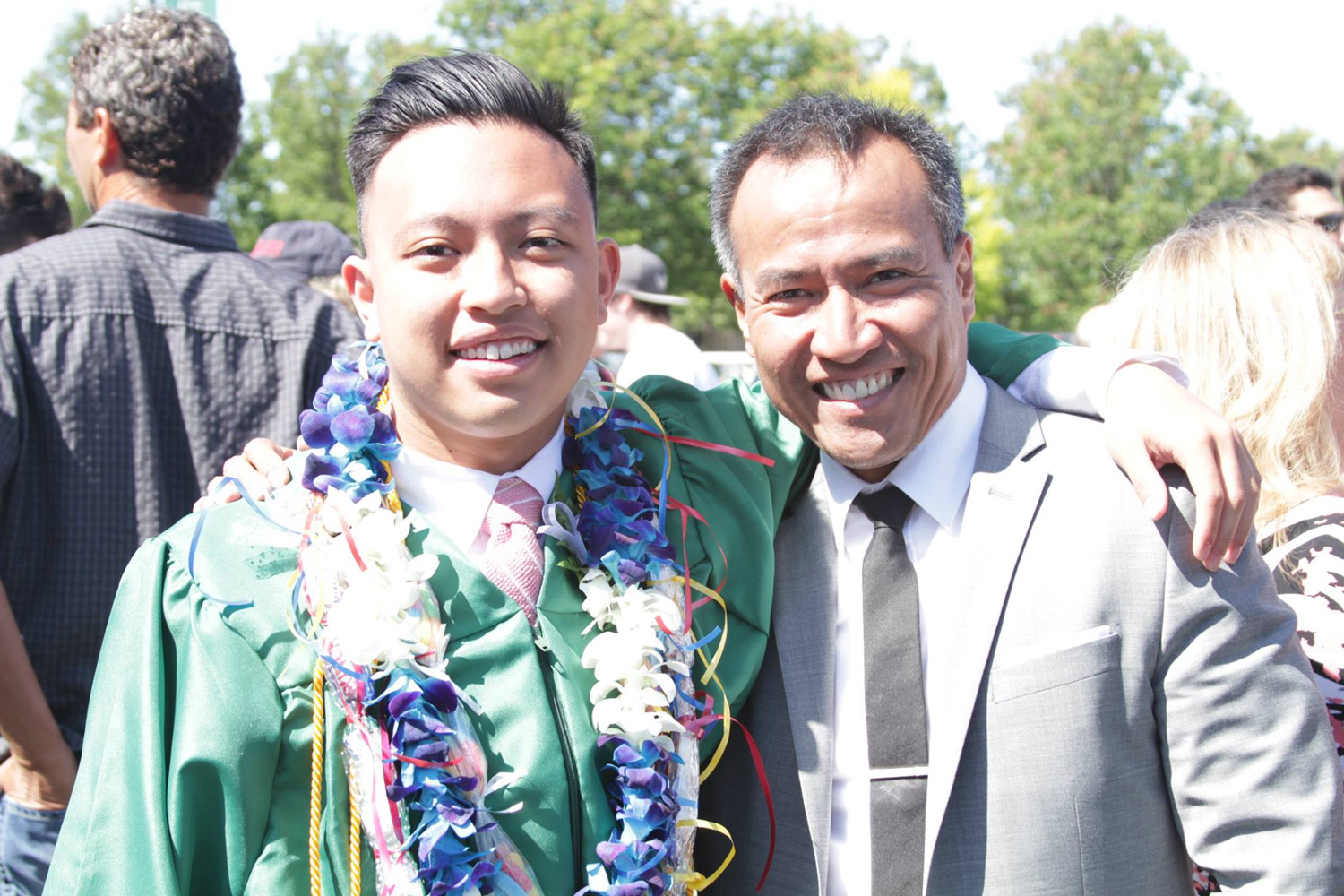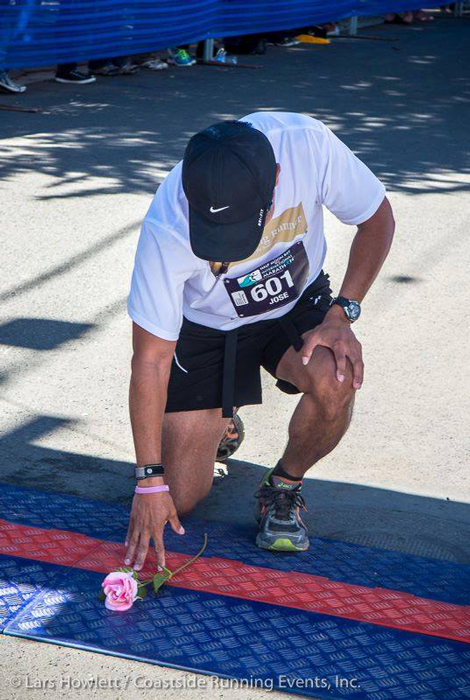Understanding Sacrifice
/Joey Cumagun, the praying runner.
In partnership with National History Day®, the Roy Rosenzweig Center for History and New Media, and the National Cemetery Administration (NCA), ABMC created this yearly program three years ago. Selected teachers choose an unknown World War II hero to set the stage for their discovery of the soldier’s life and from which they will develop a WWII history lesson plan to be accessed by middle and high school educators all over the world from their website (https://abmceducation.org).
Cumagun, a Special Education teacher at Deer Valley High School (DVHS) in Antioch, California, was picked from hundreds of teachers from all over the US and two countries who vied for this program. Working on the theme of “Understanding Sacrifice” the teachers learned about America’s role in the Pacific Theater of Operations during WWII, through immersion in lectures, reading materials, discussions, and a “walk in the footsteps of history” to places that influenced the outcome of that war and the lives of their subjects.
The teachers and the project leaders at Washington DC for the kickoff weekend of the Understanding Sacrifice 2017 Program (World War II in the Pacific) organized by National History Day and American Battle Monuments Commission. Filipino educator Joey Cumagun stands 3rd from left, front row. (Photo from National History Day Facebook Page.)
Lesson plans were based on solid scholarship, integrated with Common Core Standards, and the use of interpretive materials provided by the ABMC. The program included research and eulogies about fallen heroes of World War II who are honored at ABMC cemeteries in the US, Pacific, Southern Europe, and North Africa. For this group, the focus was on soldiers who fought for the US and were buried in San Francisco, Hawaii, and the Philippines, where the teachers traveled to present their eulogies at the completion of the program.
The Road to Teaching
Cumagun, born in Quezon City and raised in Marikina, a suburb of Manila, studied in Ateneo de Manila, where he initially pursued an Engineering program with a combined major in Computer and Physics. But immersed in a school brimming with social relevance at the time, he could not see himself at ease in the laboratory or a computer room.
“It was late in my college life, my junior year, to be exact,” recalls Cumagun, “when I decided to shift out of the Engineering program.”
The People Power Revolution of 1986 was happening at the time, and he remembers marching on EDSA. Asked how it felt to be there knowing that at any given time, the military could have used its weapons to stop them, he observed, “After being out there for a while, our fear dissipated. We didn’t care if we lived or died. Life just did not seem worth living without freedom or human rights.”
In the flurry of social changes happening in the Philippines at the time, fresh from participating in the march to depose Marcos, he and four friends from Ateneo started a group to help teach poor children the necessary values and skills to realize their dreams and potential.
“Choosing the street children of Manila as our apostolate was happenstance -- there was no socially oriented group in Ateneo dedicated to helping street children when there were multitudes of them everywhere. The group that we started in 1985, which we called “Musmos” (Tagalog term for children), is now one of the most recognized organizations in Ateneo.”
That was a decisive moment for him. “Instantly I wanted to be a teacher.”
“Joining that group was the beginning of my teaching career,” continues Cumagun. “In my senior year, I shifted from Engineering to Education.”
Special Education
After graduation, he taught history in 8th grade at Miriam College (formerly Maryknoll College) before pursuing graduate studies. It was around the time that he met his wife, Jinky, who was a pre-school teacher with a master's degree in Special Education. After they got married and had a son, they eventually moved to the US where Jinky worked as a special education teacher. Cumagun followed suit and got his teaching credential in Special Education and has been teaching in this field for over 17 years in California.
Joey Cumagun with son, Tim, who is now in Gonzaga University in Spokane, Washington, pursuing a degree in Journalism.
His students' developmental disabilities include autism, Down's syndrome, mental retardation, cerebral palsy, etc. His teaching students range from 18 to 22 years of age.
He notes, “A lot of our activities we carry out in the community. I provide them with as much community experience as possible. One of the focus in my instruction is giving students a work-based learning experience. To me, there is no better program than shaping a person’s life and directly teaching them how to be good and productive citizens.
Cumagun gets to teach in a workshop in Miriam College (formerly Maryknoll College) where he taught years before he moved to the US. “Can’t Help Falling in Love with Special Education” Workshop, July 2017, at Miriam College, Quezon City, Philippines.
“I was very excited to be selected by ABMC,” Cumagun says. “There were staff and students whose relatives fought and died in the war and are now buried in war memorials. I told my students I’m being sent to a war but an old war that’s never to be forgotten – especially the men and women who gave the ultimate sacrifice.”
With his experience in teaching special education, social studies, and history, he feels equipped to address the emotional and learning disabilities of his students as they learn about their war heroes. He hopes to move teaching to another level and dimension, with a learning trajectory that would deal with the emotional impact of war and a lesson plan designed to bring back that meaningful connection between the fallen heroes and the lives of students and staff.
His lesson plan states, “The Bataan Death March that happened during the defense of the Philippines is an emotionally charged event. This chapter in the history of World War II in the Pacific is a great subject to teach the importance of understanding emotions. Students will be able to understand what a service member felt during the Death March and have a better appreciation of the soldier’s sacrifice. For students with special needs, learning to recognize basic emotions can reinforce relationship skills and values of empathy and good citizenship.”
Choosing a War Hero
Cumagun chose to research the life of Sgt. Teofilo Yldefonzo, “because he was a Bataan Death March survivor. And he happened to be an athlete and a family man, to which I can both relate,” he explained.
Yldefonzo was the first Filipino and Southeast Asian to win an Olympic medal, and the only Filipino to win multiple medals, before serving in the military. He survived the death march but became a prisoner of war and died in the prison camp where his body was buried in a mass grave with hundreds of other Filipino and American soldiers. His remains were never recovered. Yldefonzo is memorialized on the “Walls of the Missing” at the Manila American Cemetery. (For more on this war hero’s story, check Cumagun’s historical lesson on https://abmceducation.org/understandingsacrifice/soldier/teofilo-yldefonzo.)
“I am privileged to research about the life of Sgt. Teofilo Yldefonzo of the 57th Infantry Regiment (PS) of the Philippine Scouts. He was an Olympic bronze medalist while in service. He survived the Bataan Death March but died in the concentration camp. It will be my distinct pleasure to pay tribute to him at his memorial at the Manila American Cemetery.” – Joey Cumagun
He continued, “The Bataan Death March has both fascinated and haunted me. I've taught it back in Manila, but I think I did a dishonor to those who suffered and died in the Death March by treating it merely as a factual event in Philippine history. I’ve been given a chance to remember those gallant men and women and put them in their proper place in my teaching philosophy. Moreover, I think this lesson will embody and address what ‘understanding sacrifice’ means.”
Praying Runner
A marathon runner since 2003, Cumagun actively ran with his wife and son, Tim, to stay healthy and fit. He continued to run marathons as he taught and worked on the program.
He said, “In 2006, my wife's breast cancer recurred after she battled it sometime before. I started running more marathons in her honor and in prayer.”
By 2008, he created the “Praying Runner” blog to share with others his personal journey and memories of his wife, who passed away in March of 2011. He continued to run afterwards, with his trademark pink rose laid in her memory at every finish line. Eventually he began praying for others during his run and gained a following who also cheered and prayed for him, at times meeting some of his blog readers in marathons. He runs not only to stay fit, but also “to inspire health and healing, to be positive and encouraging, and to believe in oneself that you can be the best that you can be when you set your heart and mind into it.”
Marathon #32 – running and holding the pink rose for 26.2 miles at the The SF Marathon 6/16/13 (Father's Day).
Cumagun lays down pink rose at the Finish Line – the pink rose is in memory of his wife who passed away from breast cancer in 2011.
Cumagun’s marathons started with a step towards health but have now become his “journey of peace, joy, love, and life.” He had set his goal to run 50 marathons by the time he’s 50. Things came to a head as he celebrated his 50th birthday after completing his lesson plan and delivered his eulogy for his hero, Yldefonzo, in Manila. He and his son, Tim, went for a short vacation in Japan to celebrate the end of the project and the start of a new phase in their lives as Tim nears his own finish line in college.
As Cumagun reflects on his life as a teacher and single parent, his lesson plan on war and understanding sacrifice is now ready for access around the globe; he also turned 50 last December and completed his 50th marathon on March 4, 2018. He will be ready to start another chapter of his life that will continue to involve the act of giving up something for the benefit of others, or for a higher purpose. Not surprisingly, he recently signed up to donate his kidney to an ailing family member. Suffice it to say, understanding sacrifice is definitely a lesson Joey Cumagun can teach very well.
Manzel Delacruz is a freelance writer living in San Francisco.
More articles from Manzel Delacruz









